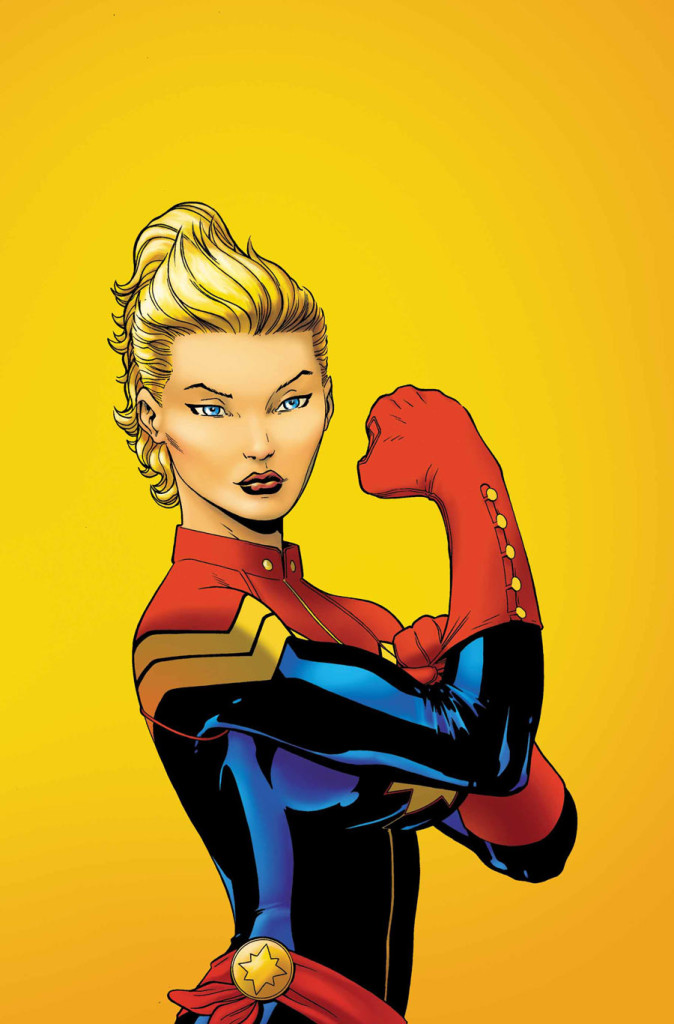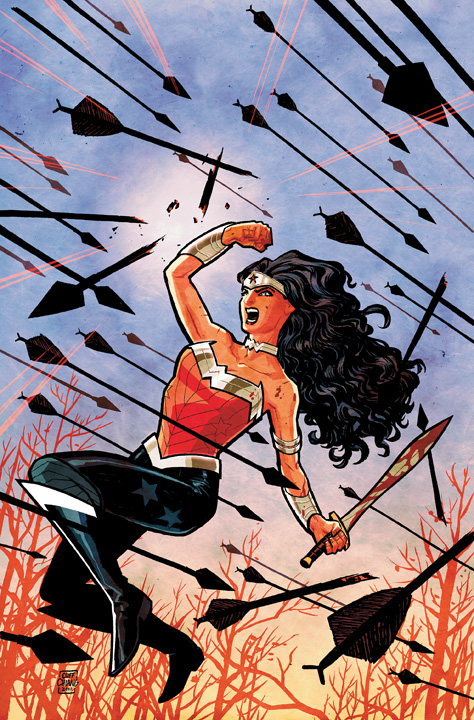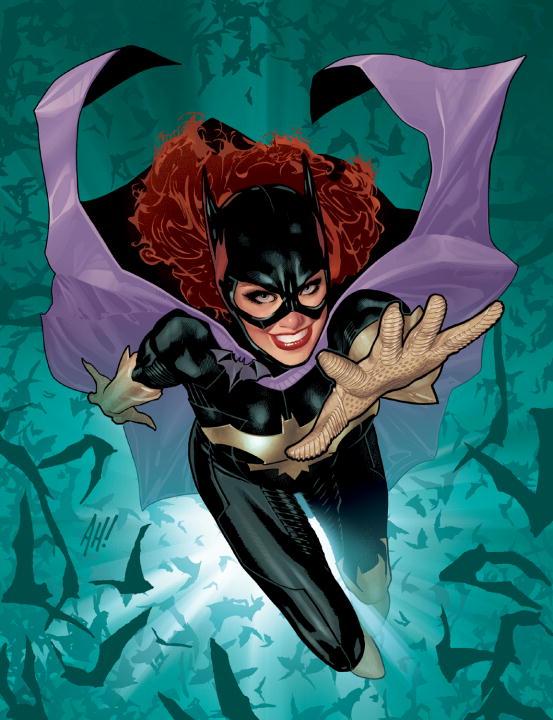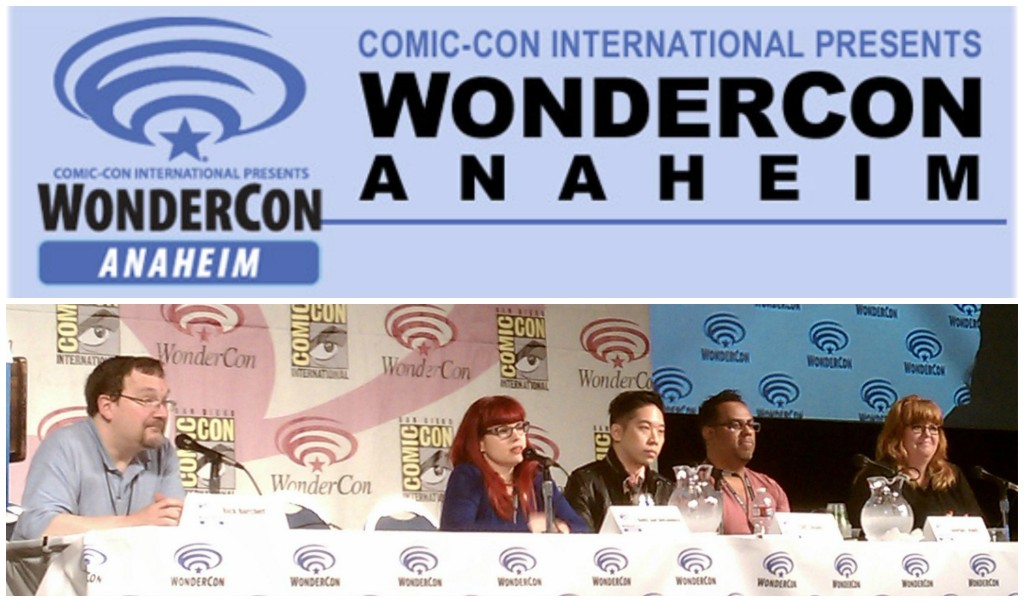The panelists, from left to right: Rick Burchett (Lady Sabre), Kelly Sue DeConnick (Captain Marvel), Cliff Chiang (Wonder Woman), Georges Jeanty (Buffy the Vampire Slayer), and Gail Simone (Batgirl).
Q: How do you define what a strong female character is?
Rick Burchett: I think, in visualizing strong female characters, you have to consider that the strength of any character – male, female, dog, cat, whatever – comes from within.
Kelly Sue DeConnick: What I’m looking for in a character of either (or any) gender – and unfortunately it’s the women who are most often shafted in this respect – is, I’m looking for agency. So what that means is that I want the character to be a human being – or alien, I don’t really give a fuck – but they need to have something that they want; they need to have an interior life. And I think that what can happen with female characters, frequently – and you can actually do this with any character, we just have a habit of doing it with women – is that you can rob them of that; we can make them into something that is just really a plot device or a motivating factor for another character. So I think some of you have probably heard me describe before something called the sexy lamp test – so if you can take a female character out and replace her with a sexy lamp, and your plot still functions, then fuck you. (The PG version of that is, then you’re a hack.) So when I’m looking for a strong female character, or a strong character at all, I’m looking for a character that has a purpose in that story; that has an interior life of some sort. And they don’t have to be physically strong, they don’t have to be morally strong, or ethically strong – because men and women come in a huge variety of all of those things, emotionally, ethically; I’m less concerned with that. I just don’t want them to be props. That’s the only thing that offends me.
 Cliff Chiang: I agree exactly with what Kelly said – and I think it does start with the writing. You know, we have to think of all these characters – we have to treat them all equally; we have to think about them having interior lives and having motivations. So when I’m drawing female characters, I’m looking for that – I’m looking for subtext, I’m looking for ways to make the reader relate to them in a way that goes beyond just the pure aesthetic values. You know, just drawing an attractive woman actually gets kinda boring after a while – you want to have some mystery, you want to have intelligence. You want to have some compassion for these characters, because when you lose that, you start seeing people as objects. So for me, I really need a good script.
Cliff Chiang: I agree exactly with what Kelly said – and I think it does start with the writing. You know, we have to think of all these characters – we have to treat them all equally; we have to think about them having interior lives and having motivations. So when I’m drawing female characters, I’m looking for that – I’m looking for subtext, I’m looking for ways to make the reader relate to them in a way that goes beyond just the pure aesthetic values. You know, just drawing an attractive woman actually gets kinda boring after a while – you want to have some mystery, you want to have intelligence. You want to have some compassion for these characters, because when you lose that, you start seeing people as objects. So for me, I really need a good script.
Gail Simone: For me, I just think that sometimes a strong female is She-Hulk punching a tank, and sometimes a strong female is a young girl crying. And there is everything in between.
Q: There’s a sort of- I think fair to say degree of need and in a way obligation to try and depict women in a stronger and better light than they have been in the past. So with that said, how do you deal – on both sides of the spectrum, writers and artists – when the person you’re working with isn’t doing as much as you feel they could be doing, either with the imagination of their visualization or with the depiction of the character in terms of the script. Have you ever had to deal with that?
Gail Simone: I have, on and off, just in terms of like, when I create a new female character, I really put a lot of effort into creating something we haven’t seen before. And so that means a whole new design, a new visual look for a character. And when I created Scandal Savage, I wanted her to be very short, kind of strong and thick, and that’s the way she was designed at the beginning – and just over time, she got taller, bustier, slimmer, more curvy, and so I’m like, remember, she’s supposed to have this certain body type that we haven’t seen in two hundred other female characters… So that does come up sometimes.
Kelly Sue DeConnick: I’ve been really, really lucky for the most part – I’ve been super sympatico with most of my artists. Every once in a while there’s been a thing or two that’s happened – and strategically placed word balloons can sometimes cover a multitude of sins. There’s also, with the time-table that you’re working on- art fixes are just not something that can happen, so you just kind of have to work around it, because of the reality of the 30 day schedule. And also there’s a reality of my place on the totem pole, where you know, I can say, well, the fact that I can see both of her butt cheeks and both of her breasts at the same time is really not ideal. But yeah, well, it’s already inked, so we’re going to deal with it. However, I have a story for you – so I don’t have the pull to get that kind of stuff fixed on a short schedule, but I just did an arc with Warren Ellis. And no one else on the planet could get away with this, ’cause I think it’s like harassment, but there was a depiction of Spiderwoman where she was- her waist perhaps didn’t contain any internal organs. And Warren suggested very quietly, yes, you should fix that, or else I will come to your house, and nail your feet to the floor, and set your house on fire. And, it totally got fixed.
Q: So, no matter how well you depict the personality and the heart and the intelligence and spirit of a woman, they still remain in these sort of idealized packages. Does that frustrated you? And how do you see things improving in the future, in terms of that?
 Rick Burchett: Well, more women are reading comics than probably ever. I saw numbers that say that 46% of comic readers are now women. That’s a pretty good percentage. And I think that’s going to have a lot to do- but I think you have to keep in mind that we deal in fantasy. And I don’t want a superhero to look like me. But I think, women have been sexualized much more than men have been, and I think they’ve been objectified a lot more, and I think there’s progress to be made in that area. I think we’ll be seeing women who look athletic, obviously, but don’t look like exotic dancers.
Rick Burchett: Well, more women are reading comics than probably ever. I saw numbers that say that 46% of comic readers are now women. That’s a pretty good percentage. And I think that’s going to have a lot to do- but I think you have to keep in mind that we deal in fantasy. And I don’t want a superhero to look like me. But I think, women have been sexualized much more than men have been, and I think they’ve been objectified a lot more, and I think there’s progress to be made in that area. I think we’ll be seeing women who look athletic, obviously, but don’t look like exotic dancers.
Kelly Sue DeConnick: Actually I think that athletic builds have a really wide breadth. I think there are all kinds of different athletic women that don’t- and I’m not saying this is what you said, Rick – but this is a thing that creeps into this conversation a lot, a thing where, if you complain about the depiction of women, then it becomes: well, but ladies, the dudes are idealized too. And the thing is that the dudes are idealized for strength, and the women are idealized for sexual availability. It’s very, very different. The women’s costumes are cut in such a way that I could give a cervical exam to many of our heroines – and I don’t have a degree, so if I can find it, that’s impressive. But the thing is, there’s a couple of things about that that bother me – in particular it bothers me because it assumes a heterosexual male reader. And when we say things like, there are more women reading comics now than ever – that’s actually not true. It used to be that comics were pretty evenly distributed – like everybody read comics, right. And if you go back and find old pictures of kids at the newsstands reading comics – it’s girls, boys, everybody. Then there was this thing that happened in really fairly recent history, where it became this accepted wisdom that comics were adolescent male fantasies, and that those were the- that was the readership that kept the industry alive.
Gail Simone: Well, and that Archie was for girls, and everything else was for boys.
Rick Burchett: But that was only in the 1960’s. Prior to that, Simon and Kirby did romance comics, and they sold in the millions every month.
Gail Simone. Take a look at the original characters of Lois Lane, Black Canary and Wonder Women – some of our strongest, best female characters, and then through decades of things happening to them, they just became weaker and weaker. And you know, that didn’t appeal to the female reader anymore.
Q: So, the other thing I have to applaud you for – one of the things that I’m aware has gone away, which you definitely have been a part of, is the flip side of that: if you did what was perceived as a strong female character, then they were just sort of like angry bitches who were unpleasant to everyone. And that was a sort of 70’s thing, I think – but people like you have helped to take it to the next stage-
Kelly Sue DeConnick (tongue in cheek): Super Bitches.
Q: So bravo… So here’s a personal thing: what is the proudest moment of your work, in terms of depicting women?
Gail Simone: When I first came into the industry, I was writing Simpsons comics and Deadpool – which by the way is one of the most testosterone filled comics ever – and then I was given the opportunity to write Birds of Prey. And I said, well, I am going to prove that three female characters can work together, be in a book together, be entertaining and be successful without having bitch fights over boyfriends, talking about makeup and shopping all the time, talking about dating and who’s going to date who and going behind each other’s back and dating the other one’s-
Kelly Sue DeConnick: And only ever eating salads or ice cream.
 Gail Simone: Exactly. And they were going to have missions, and they were going to accomplish things and work together – even though they didn’t agree with the methods all the time, they were going to get it done. And I told Dan at the time, I said, I am going to prove to you that these female characters have value outside of just being the male hero’s girlfriend or plot point once they get de-powered or killed or whatever. And I think accomplishing that is probably the proudest thing.
Gail Simone: Exactly. And they were going to have missions, and they were going to accomplish things and work together – even though they didn’t agree with the methods all the time, they were going to get it done. And I told Dan at the time, I said, I am going to prove to you that these female characters have value outside of just being the male hero’s girlfriend or plot point once they get de-powered or killed or whatever. And I think accomplishing that is probably the proudest thing.
Georges Jeanty: I think the thing I’m most proud of, with this book [Buffy] more than any other book I’ve ever done, I’ve had more women come up to me and say, I’ve never read a comic book, but as soon as I saw that Buffy was going to be in a comic book form, I had to go pick it up. And I thought that was great – and more, I would say nine times out of ten, the women who did pick it up said, I then saw this, or I saw Fables or I saw Catwoman or I saw another book – and it was a very proud thing, for me at least, to be the gateway drug to this world that we all live in.
Audience Q: Talking about the future of women in comics and what direction they can go in, I was wondering if you had a choice of something you’d like to see done with a female character – what would you like to see them do that you haven’t seen?
Kelly Sue DeConnick: I’d love to see – I don’t think I can say this has never been done, but I’d like to see more women competing and remaining friends. That is a thing that I see in my regular life – I have a lot of women friends, and we’re very competitive and we’re very driven, but we don’t miraculously break out into catfights. I think there’s a thing, like, dudes are allowed to make each other better, and we’re not – in pop culture, we’re not represented that way; we’re represented as conniving and manipulative and we’re really usually after the attention of a dude. And I’m sorta over that.
Audience Q: You were talking about the sexy lamp test earlier, and how women were portrayed in the 70’s as super bitches – so as writers and artists, how do you strike the balance between vacuous sex toy and super B?
Kelly Sue DeConnick: Just pretend they’re people! Whatever woman you can imagine, there’s a woman like that. Or if it’s really problematic, write them all like men and change the names!
Cliff Chiang: One of the things I’m surprised about the most is how we’ve gotten really used to the dial being turned up to like way too sexy.
Gail Simone: There are a lot of different kinds of sexy too y’all.
Cliff Chiang: Exactly. And the thing is, we do have to speak out about it. It’s not as though, when I’m drawing, if my hand slips suddenly it’s too sexy. There’s a bunch of steps that get there – okay, that is a thong that you just drew. Those breasts are too big. These are conscious decisions that someone’s making, and there are many of them, and you don’t just do them by accident. So as creators, I think it’s important for us to rein that in, because it doesn’t help the stories. And it’s important to speak out about it and say, this is kind of ridiculous. So, let’s try to have respect for each other.
Audience Q: Gail, what do you most want to see in female characters in comics, going forward?
Gail Simone: I just want variety.







Nice! I am sad I missed this panel but glad you got to go. I think they all make good points, too. There is room for some much more for women in comics and they don’t all have to wear bikinis to fight in.